Imagine a marathon athlete puffing on cigarettes during the 22.38-mile run. But chess was the only sport where smoking was not only possible; it was quite common. For some mental athletes, such as the late world chess champion Mikhail Tal or the legendary grandmaster Viktor Korchnoi, performing without cigarettes was unthinkable.
The late Dutch grandmaster Jan Hein Donner was a chain smoker and so was I, and when we played against each other, the chessboard disappeared in a cloud of smoke. We lived under the illusion that cigarettes can calm our nerves and even stimulate us to make good moves.
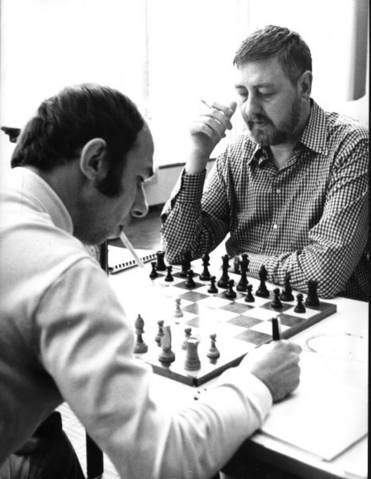
Our cigarette duel with Donner (right) in Amsterdam in 1973
During our game at the traditional tournament in Wijk aan Zee in 1969, Donner made a major discovery in the Najdorf Sicilian. He boldly steered his king to the kingside where I was about to launch a devastating storm. I thought I could sacrifice three pawns, leap with my knight into his stronghold and claim a full point with a powerful attack. But my fellow smoker found a nice defense and the game was eventually drawn.
Kavalek,Lubomir - Donner,Jan Hein
Wijk aan Zee 1969
1.e4 c5 2.Nf3 d6 3.d4 cxd4 4.Nxd4 Nf6 5.Nc3 a6 6.Bg5 e6 7.f4 Be7 8.Qf3 Qc7 9.0-0-0 Nbd7 (The starting position of the Najdorf Sicilian Main Line.)
10.g4 (Playing through the center with 10.Bd3 is another popular idea.) 10...b5 11.a3 (An older idea: before proceeding with his kingside plan, white stops black's counterplay on the opposite wing. The immediate 11.Bxf6 Nxf6 12.g5 Nd7 13.f5 0-0!? is a variation on Donner's idea as we will see below.) 11...Rb8 (Supporting the counterplay with b5-b4, the rook move was always regarded as the best.)
12.Bxf6 Nxf6 13.f5 (Hitting the pawn e6 before playing g4-g5 puts some pressure on black.) 13...0-0!? (I could not believe what I saw. I expected something like 13...e5 14.Nde2 h6 to stop my kingside advance. Was Donner joking, castling under a mating attack? I know he was a brilliant defender who believed he could survive any onslaught. Bringing him to his knees was difficult, but the short castle seemed to be too much to go unpunished. It turned out, he made a profound judgement over the board. We were on our own: no home preparation, no seconds, no computers.)
14.g5 Nd7 (When we arrived at this position, I thought black should be crushed and it didn't take me long to find how to proceed.)
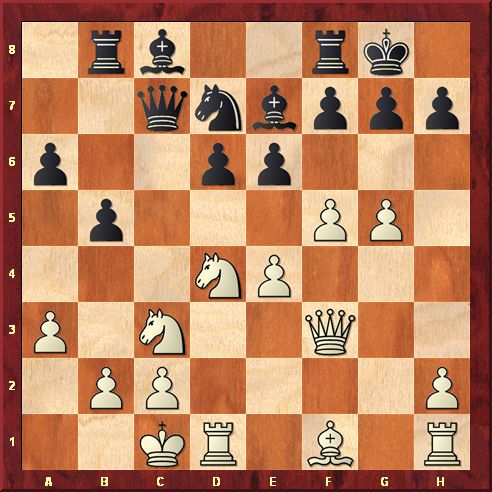
15.f6!?
(The introduction to the three-pawn sacrifice, hoping to open the g-file and to strip the black king from pawn protection. I have to admit, it's a pretty violent solution, but black is ready to strike with b5-b4 and white's reaction is understandable.
After 15.fxe6 fxe6 16.Nxe6 Bxg5+ 17.Kb1 Rxf3 18.Nxc7 Nc5 black's pieces come alive, for example 19.Rxd6 Rxc3! 20.bxc3 Bb7, threatening 21...Nxe4 or 21...Bf4.)
15...gxf6! (15...Bd8 is too passive.) 16.gxf6 Nxf6 17.e5! (Not only preparing the knight leap, but also opening the diagonal h7-b1.) 17...dxe5 (After 17...Bb7? 18.Qg3+ Kh8 19.exf6 Rg8 20.Qh4 wins.)
18.Nc6!
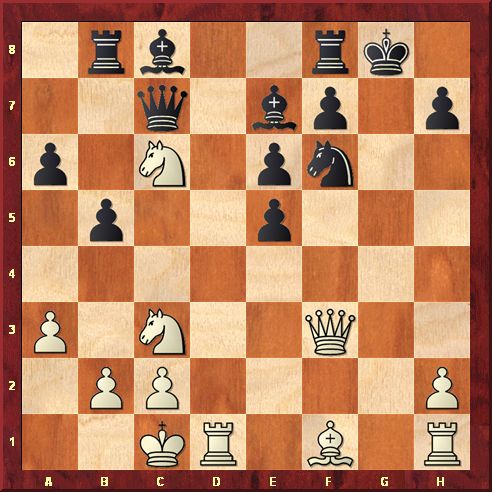
(The main point of the leap is not to attack the rook on b8, but to bring the knight to e5, after Qf3-g3+, and create dangerous threats.)
18...Kh8! (A brilliant defense, eliminating 19.Qg3+. After 18...Bb7 19.Qg3+ Kh8 20.Nxe5 white threatens either to win the queen with a discovered knight check (Ne5-g6+) or to end it with a smothered mate after, for example, 20...Rbc8? 21.Rg1 Nh5 22.Qg8+!! Rxg8 23.Nxf7 mate.

Black has better alternatives after 20.Nxe5:
a) 20...Bd6!? 21.Rg1 Nh5!? (21...Rg8 22.Nxf7+ Qxf7 23.Qxd6²) 22.Nxf7+ Rxf7 23.Qxd6 Qxd6 24.Rxd6 Rbf8 25.Bd3 Nf4 26.Kb1 and white's advantage is small.
b) 20...Bd8 21.Rg1!? Nh5 22.Qe3! Bf6 and the unfortunate position of the rook on b8 allows the fork 23.Nd7 with white's edge.
It seems 21.Rxd8 is not as strong: 21...Rbxd8! and black gets plenty for the queen: 22.Ng6+ hxg6 23.Qxc7 Bxh1. But not 21...Qxd8? 22.Rg1 Nh5 (22...Ng4 23.Qxg4 wins) 23.Qg8+!! Rxg8 24.Nxf7 mate.
19.Nxb8 Qxb8!? (Donner plays with imagination, sacrificing the exchange. Black also has 19...Bb7 20.Nxa6! Bxf3 21.Nxc7 with equal chances, for example 21...Bxh1 22.N7xb5 Bc6; or 21...b4 22.Bg2 Bxg2 23.Rhg1 Bf3 24.Rdf1 e4 25.axb4 Bd6 26.N7b5 Bxh2 27.Nd4 Bxg1 28.Rxg1=)
20.Bg2 (I wanted to control the diagonal h1-a8. GMs Svetozar Gligoric and Dragoljub Velimirovic suggested 20.Rg1 Bb7 21.Qg3 Rg8 22.Qf2 and the chances are roughly equal, although it is clear black has plenty of material for the exchange.) 20...b4 21.axb4 Qxb4 22.Rhe1 Qf4+ 23.Qxf4 (23.Kb1 would give white better prospects.) 23...exf4 (Black has a good compensation for the exchange and splitting the point after some dramatic play was a fair result.)
24.Bf3 Bc5 25.Kb1 Be3 26.Rd6 Nd7 27.b4 Ne5 28.Be2 Bb7 29.Nd1 Ba7 30.Bxa6 Bb8 31.Rb6 Nf3 32.Re2 Ba8 33.c3 Bc7 34.Rb5 Be4+ 35.Rxe4 Nd2+ 36.Kc2 Nxe4 37.Rb7 Bb8 38.Bd3 f5 39.Re7 e5 40.c4 Bd6 41.Re6 Bxb4 42.Rxe5 Bd6 43.Re6 Bb8 44.Bxe4 fxe4 45.Rxe4 f3 46.Re1 Bxh2 47.Rf1 Bd6 48.Kd3 Bc5 49.Ke4 f2 50.Kd3 h5 51.Nxf2 Draw.
We didn't pay much attention to this game afterwards and Donner's idea lay dormant for four decades. A lot has changed since. Smoking, for one, is not allowed in chess tournaments anymore.
Had we thought about castling short one move earlier, it would have reshaped the Main line of the Najdorf Sicilian and pages and pages of analyses would have become useless. The difference was in the placement of black's rook, only one square apart. The idea would have remained intact and Donner's plan would have still retained its punch.
It was precisely what the Chinese discovered recently. Donner's bold stroke, in a slightly altered form, emerged in the games of the young Chinese woman grandmaster, Ju Wenjun,21. Last year, she played the variation against the three Russian sisters, Nadezhda and Tatiana Kosintseva and their sister-in-arms, Alexandra Kosteniuk.
Earlier this month in the German Bundesliga, Alexei Shirov tried to trash the idea the same way I did against Donner and won. A few days later, Ju Wenjun had the answer to Shirov's attack in the game against the new Turkish champion, Dragan Solak. It was played at the Aeroflot Open in Moscow that ended Wednesday. The Polish GM Mateusz Bartel won the event on tiebreak. He edged out two Ukrainian grandmasters, Anton Korobov and Pavel Eljanov. All three scored 6.5/9.
The Chinese Donner
Donner was one of the greatest chess writers and a leading Dutch player following the world champion Max Euwe's reign and before the emergence of Jan Timman. Donner was also the first Western grandmaster to be defeated by a Chinese player in a game that became known as the Chinese Immortal. I think it's time the Chinese paid him back and called the variation used by Ju Wenjun - the Chinese Donner.
1.e4 c5 2.Nf3 d6 3.d4 cxd4 4.Nxd4 Nf6 5.Nc3 a6 6.Bg5 e6 7.f4 Be7 8.Qf3 Qc7 9.0-0-0 Nbd7 10.g4 b5 11.Bxf6 Nxf6 12.g5 Nd7 13.f5 0-0!?
The accelerated Donner line, a personal toy of the young Chinese player Ju Wenjun. If this line works - and it seems it does - black can avoid the complicated lines 13...Bxg5+ 14.Kb1 Nc5; or 13...Nc5 14.f6 gxf6 15.gxf6 Bf8, which were not easy to play for black.
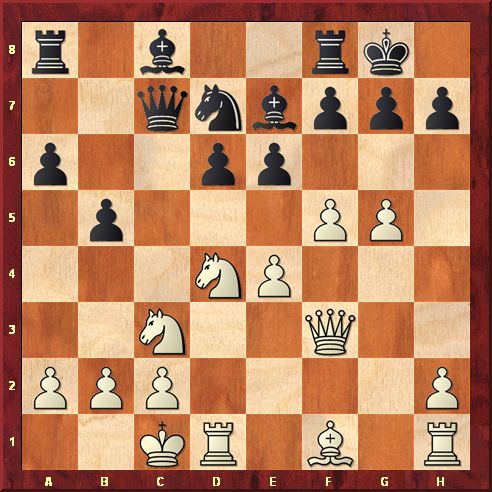
14.f6!?
During the first February weekend, Alexei Shirov followed my footsteps and played this pawn breakthrough in a Bundesliga game against Niclas Huschenbeth.
Let's see how Ju Wenjun fought against white's other options:
A. 14.h4 b4 15.Nce2 e5 16.Nb3 f6!? The white attack is stopped and black won in 40 moves in Savchenko -Ju Wenjun, Moscow 2012 .
B. 14.fxe6 fxe6 15.Qe3 [15.Nxe6 Rxf3 16.Nxc7 Bxg5+ 17.Kb1 Rb8 18.Ne8 Ne5 black has active play.] 15...Qc5 16.h4 Nb6 Black equalized in Kosintseva,N -Ju,W, Nalchik 2011, and won in 54 moves.
C.14.Rg1 b4 15.Nce2 e5 16.f6 exd4 17.fxe7 Re8 18.Nxd4 Ne5 19.Qf4 and now instead of 19...Rxe7 as in Kosintseva,T - Ju Wenjun, Nalchik 2011, black played 19...Be6 20.Kb1 Rxe7 21.Nf5 Rd7 22.Rg2 Rad8 23.Ne3 d5 with good game in Kosteniuk-Ju Wenjun, Beijing 2011.)
14...gxf6 15.gxf6 Nxf6 16.e5! dxe5 (After 16...Bb7 17.Qg3+ Kh8 18.exf6 Bxf6 19.Rg1 black doesn't have adequate compensation for a piece.)
17.Nc6!
We reached a postion almost identical from my game against Donner. The only difference is in the placement of the black queen's rook

Shirov, Alexei - Huschenbeth, Niclas
Bundesliga 2012:
Black chose Donner's king move 17...Kh8? and turned a brilliant defense into a losing blunder. Shirov simply picked up the rook: 18.Nxe7 Qxe7 19.Qxa8
(Black probably realized that after 19...Bb7 20.Qa7 Ra8 21.Qe3! Bxh1 22.Qxe5 pinning the knight was too strong, for example 22...b4 23.Bd3 bxc3 24.Rxh1 Kg7 25.Rg1+ Kf8 26.Rf1 Ng8 [After 26...cxb2+ 27.Kb1 Ng8 28.Bxh7 f5 29.Bxg8 Kxg8 30.Rxf5 white wins.] 27.Qxc3 the black king and scattered pawns give white a clear advantage.)
Huschenbeth played 19...b4 instead, and Shirov could have simply retreated 20.Ne2, for example 20...Bb7 21.Qa7 Ra8 22.Qg1 Rg8 23.Ng3 Bxh1 24.Qxh1 Ng4 25.Rd2 with a decisive advantage.
Instead, he played 20.Qb8 Nd7 21.Qc7 bxc3 22.Qxc3 Qg5+ 23.Kb1 (23.Qd2 is even stronger.) 23...Bb7 and now he should have tried 24.h4! Qh5 25.Bxa6 Bxh1 [or 25...Bxa6 26.Rxd7] 26.Rxh1 with a big edge. He played 24.Bxa8 and won anyway in 43 moves.
Solak,Dragan - Ju Wenjun
Aeroflot Open, Moscow 2012:
17...Bb7! ( An improvement on Shirov' game.)
18.Qg3+ Kh8 19.Nxe5
( White threatens to win the queen with 20.Ng6+ and black has two ways how to defend, since 19...Rac8 is unacceptable because of 20.Rg1 for example 20...Nh5 21.Qg8+!! Rxg8 22.Nxf7 mate.
19...Bd6
(19...Bd8 is another way to protect the queen. And now:
A. 20.Rg1 Nh5 (20...Rg8? 21.Rxd8 Raxd8 22.Ng6+ Rxg6 23.Qxc7 and the rook on d8 is hanging.) 21.Qe3 Bf6 easily holds for black.
B. 20.Rxd8 Raxd8 [20...Qxd8 21.Rg1 Ng4 (21...Nh5 22.Qg8+ Rxg8 23.Nxf7#) 22.Qxg4±] 21.Rg1 Ne8 22.Qg5 and as computer engines suggested, white has enough pressure to draw, but not more. For example:
22...b4 23.Bb5! f6 [Not 23...axb5? 24.Nxb5 f6 (24...Qc5? 25.Qg8+ Rxg8 26.Nxf7 mate.] 25.Qh6 Qg7 26.Rxg7 Nxg7 27.Ng6+ Kg8 28.Nxf8 and white wins.) 24.Qh6 Ng7 25.Ng6+ Kg8 26.Nxf8 Rxf8 27.Bd3 f5 28.Na4 Qe5 29.Nc5 Bc8 30.Nxa6=
Or 22...Rd7 23.Bxb5!? f6! [ Not 23...axb5? 24.Nxb5 Qd8 25.Nxf7+! wins.] 24.Qh6 Rg7 25.Rxg7 Qxg7 26.Ng6+ Kg8 27.Qxg7+ Kxg7 28.Nxf8 Kxf8 29.Bd3 f5 with equal chances.
20.Rxd6! (Since the rook is still on a8, 20.Rg1 is met by 20...Rg8! and black wins.) 20...Bxh1 (20...Qxd6 21.Rg1 Ng4 22.Nxf7+ Rxf7 23.Qxd6 wins.)
21.Rd1
(It is not clear white can secure a draw with 21.Qg5, for example:
A. 21...Ng4!? 22.Nxg4 f6!? [White has a draw by perpetual check after 22...f5 23.Ne5 Qxd6 24.Ng6+ hxg6 (or24...Kg7 25.Ne5+ Kh8 26.Ng6+=) 25.Qh6+ Kg8 26.Qxg6+=) 23.Qd2 Bd5 24.Rxd5 exd5 25.Nxd5 Qg7 26.Nge3 Rae8 is unclear, perhaps slightly better for black.
B. 21...Ne4 leads to a draw after 22.Nxe4 Bxe4! [Not 22...f6 23.Nxf6 Qxd6 24.Ng6+ Kg7 25.Nh5+ Kf7 (or 25...Kg8 26.Ne5+ Kh8 27.Qg7 mate.) 26.Ne5+ Ke8 27.Ng7 mate.] 23.Qf6+ Kg8 24.Bd3 Qc5! [24...Qxd6 25.Ng4 wins.; 24...Bxd3 25.Rxd3 wins.] 25.Bxe4 Qe3+ 26.Rd2 Qxe4 27.Qg5+ Kh8 28.Qf6+.)
21...Rac8!? 22.Bd3 Bb7 23.Qg5 (The bishop sacrifice 23.Bxh7 seems strong at first, since 23...Nxh7 24.Rd7 Qc5? 25.Rxf7! wins, but the computer finds 23...Bf3! equalizing: 24.Bd3 Bxd1! 25.Kxd1 25...Nh7 26.Bxh7 Kxh7 27.Qh4+; or 25...Rfd8 26.Qh4+ Kg7 27.Qg5+ Kf8 28.Qxf6 b4 29.Qh8+ Ke7 30.Qh4+ Ke8 [30...f6 31.Ng6+] 31.Qh8+= )
23...Ng8 24.Bxh7! (Forcing a draw. After 24.Qh4 f5 25.Bxf5 Rxf5 26.Rd7 Qxd7 black is fine.)

24...Qe7! (After 24...f6 25.Qh4 Qxh7 26.Ng6+ Kg7 27.Rd7+ wins.) 25.Qh5 Nf6 26.Qh4 Ng8 27.Qh5 Nf6 28.Qh4 Ng8 29.Qh5 Nf6 30.Qh4 Draw.
The Chinese Immortal
At the chess olympiad in Buenos Aires in 1978, Donner lost to a Chinese master, Liu Wenzhe. Liu's victory was brilliant, the first defeat of a Western grandmaster by a Chinese player.
After he lost the game, Donner sat in his chair for another 15 minutes, staring at the chessboard with amazement. And then, understanding the humor of the situation, he mocked himself: "Now I will be known as the Chinese Kieseritzky."
Lionel Adalbert Bagration Felix Kieseritzky (1806-1853), became famous, perhaps unfairly, for losing to Adolf Anderssen in London in 1851 in what became known as the Immortal Game.
Liu was one of the first Chinese chess coaches. He revealed his training methods and secrets in the book Chinese School of Chess. His game against Donner was dubbed "the Chinese Immortal."
Liu, Wenzhe - Donner,Jan Hein
Buenos Aires (ol), 1978
1.e4 d6 2.d4 Nf6 3.Nc3 g6 4.Be2 Bg7 5.g4!? (Sharp, very sharp. Donner is under a bayonet attack.) 5...h6?! 6.h3?! (This slow move tricked Donner into castling short.) 6...c5 7.d5 0-0?! 8.h4! ( Donner was amused by the double-step of white's h-pawn. ) 8...e6 9.g5 hxg5 10.hxg5 Ne8? (Not only is this retreat passive, but it jams the black king. Black had to play 10...Nh7 11.f4 exd5 12.Nxd5 Re8.) 11.Qd3! (White simply plans to bring his queen to the h-file with a devastating effect.) 11...exd5 12.Nxd5 Nc6 13.Qg3 Be6 14.Qh4 f5 15.Qh7+ Kf7
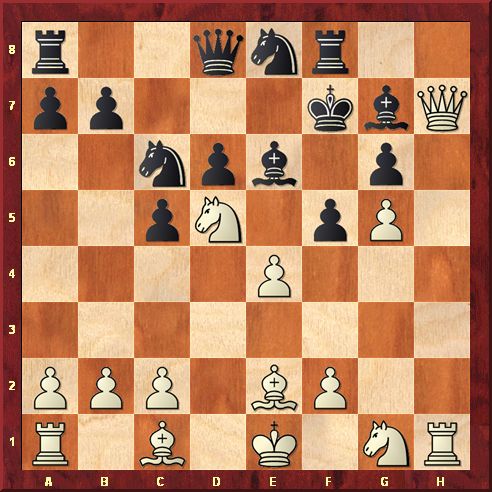
16.Qxg6+!! (A wonderful queen sacrifice! Black is mated in 7 moves.) 16...Kxg6 (After 16...Kg8 17.Qh7+ Kf7 18.Bh5 mate.) 17.Bh5+ Kh7 18.Bf7+ Bh6 19.g6+ Kg7 20.Bxh6+ (After 20...Kh8

21.Bg7+! Kxg7 22.Rh7 mates.)
Black resigned.
A guide to opening novelties
Tournament players can follow new opening ideas easily today. Here are some of the major choices with brief descriptions:
•The Chess Informant, first published in 1966 in Belgrade, has been the main choice of many tournament players for decades. Almost every world's top player used to write for them. It has been languishing lately, but is trying to make a comeback with their 113th publication. They are bringing Garry Kasparov on board in a "Garry's choice" column and there are many more textual columns in English.
•They recently published 1000 TN!!, a 640-page collection of 1000 best theoretical novelties from 1971 to 2011, selected by world-class players. It maps the opening evolution of the last 40 years.
•New in Chess Yearbook has developed into a major theoretical publication after their initial cooperation with the Informant in the 1980s didn't work out. NIC published 101 Yearbook editions, four in a year. They attracted leading opening experts to write for them. Kasparov contributed to their 100th anniversary issue.
•Chess Evolution, produced in cooperation with Quality Chess, is a bi-monthly publication that started last year. Strong grandmasters dissect important games in depth in English. They write mostly about new opening ideas, but there are also endgame and puzzle sections.
•Chessbase Magazine follows a similar trend on CDs, but on a large scale. They report on tournaments, interview players, follow opening trends, analyze endgames and use videos. You can also download the contents. The Chessbase 10 or 11 programs in combination with Mega 2012 database weekly updates can also provide openings news.
•Chess Today, GM Alexander Baburin's daily online newsletter, has been a wonderful source of information for many tournament players. First published in 2001, it consists of 4018 issues (!). The writers comment on theoretical novelties, middlegame tactics and endgames and review chess publications. Their other main analyst, GM Mikhail Golubev, keeps a close watch on anything Sicilian and King's Indian.
Note that in the replay windows below you can click either on the arrows under the diagram or on the notation to follow the game.
